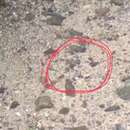Biology
(
Inglês
)
fornecido por Arkive
This diurnal fish feeds on algae, diatoms, and invertebrates (3). Mating is polygynous, following a consort-pair mating system in which the male closely follows behind an egg-bearing female for up to one hour, with the pair periodically descending to spawn in the algae (4) (7). Males will prevent other male competitors from interfering by blocking the intruder with his body but exhibits little aggressive behaviour (7). Although capable of breeding throughout the year, most of the species' reproductive effort is concentrated in April and May (4). It takes an average of seven days for eggs to hatch, with the young reaching sexual maturity eight to ten weeks later (7), but growth and development are dependent on food supply (3). This fish rarely lives for longer than 12 months (7).
Conservation
(
Inglês
)
fornecido por Arkive
In the 1970s the Devil's Hole pupfish was the focus of a famous U.S. Supreme Court water rights case, brought by the federal government against a farming concern that was pumping water from wells associated with Devil's Hole (5). In 1976 the courts decided in favour of the fish, upholding a lower court order to establish a minimum water level in Devil's Hole that would ensure the continued existence of the pupfish (4). In 1984, The Nature Conservancy (TNC) was able to purchase the surrounding land and create Ash Meadows National Wildlife Refuge to protect the area's unique fauna (5) (7). Artificial lights have been installed over the shallow breeding shelf to stimulate diatom and algae growth to provide more food to the pupfish, and routine census taking was also instituted (4).
Attempts have been made to relocate some of the population and induce spawning in other environments such as the Steinhart Aquarium in San Francisco, but have mostly been unsuccessful (7). The idea is that spreading the fish out would minimize the possibility of the species being wiped out completely by a single catastrophic event (7) (10). Fortunately, efforts to rear the fish in a tank near Hoover Dam have proved successful, with an original sample of just eight individuals having grown to over 74 (7) (10). However, individuals here have exhibited different growth patterns to those in the wild and no one is sure if these fish could survive if released into the wild (7) (10). Wildlife biologists are therefore planning to build another refugium that better replicates the actual conditions of water temperature, oxygen content, sunlight and algae in Devil's Hole (10). These findings only serve to demonstrate how this pupfish, as perhaps one of the most geographically isolated organisms in the world, is highly adapted to its unique environment (7) and, despite significant conservation efforts, remains in an extremely precarious position (4).
Description
(
Inglês
)
fornecido por Arkive
Found only in a single desert spring in Nevada, USA, this tiny fish has the most restricted range of any vertebrate (2). The smallest of all pupfish, this unique species lacks pelvic fins and the distinctive barring so common among other pupfish (2) (4). The fins are large and rounded with dark edges, and the dorsal and anal fins are located far back on the body (5). As with all pupfish, the sexes of this species are differently colored. Males are silvery with iridescent neon-blue sides, which change to metallic green or golden under different angles of light (4) (6). The female is smaller and more yellowish-brown, with the young resembling females (4) (7).
Habitat
(
Inglês
)
fornecido por Arkive
Devil's Hole is a rock-bound spring pool that lies about 15 metres below the land surface, constituting a limestone rock shelf about 0.3 metres below the water surface and a very deep subterranean reservoir (4) (7). This species occupies the upper 30 metres of the pool, frequenting the limestone shelf, which provides sunlight exposure and access to food, as well as a site for spawning (3) (7). The water temperature stays a constant 32 to 34 ºC (4) (7).
Range
(
Inglês
)
fornecido por Arkive
Confined to Devil's Hole, which is a deep, isolated pool in Ash Meadows, part of the arid Death Valley region of Nevada, USA (3) (7). The entire population feeds and breeds in an area of approximately 20 square metres (8).
Status
(
Inglês
)
fornecido por Arkive
Classified as Vulnerable (VU) on the IUCN Red List (1) and listed as Endangered on the U.S. Endangered Species Act 1967 (3).
Threats
(
Inglês
)
fornecido por Arkive
With such a restricted range, the population of Devil's Hole pupfish has been small for a long time, but was first observed to be undergoing declines in the 1960s. This decline was largely attributed to water-management practices that pumped out groundwater for crop irrigation and desert development, thereby reducing the water level in Devil's Hole; and water loss continues to pose a major potential threat to the species (3). Since these fish feed and breed on the limestone shelf just a few inches below the water's surface, lowered water levels could easily push the Devil's Hole pupfish to extinction. Nature also seems to have worked against the pupfish, with flash floods in 1973 and an earthquake in 1978 carrying large amounts of debris into the pool and creating water disturbance, which scoured away much of the algae on which they feed and in which they spawn (4). Again, as much as half of the population (total population varies from 200 to 800 depending on the time of year (7)) was destroyed in 2004 when, in a terrible twist of irony, flash floods unexpectedly forced scientific research equipment designed to preserve the endangered species into the pool (9)!

